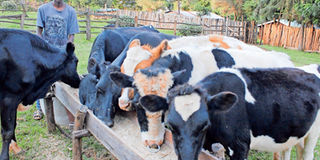Vet on call: When the veterinary eats his own patient

Tonny Kiprotich feeds cattle in a farm in Elburgon. The farm sells bulls for slaughter at between Sh80,000 and Sh120,000. PHOTO | JOHN NJOROGE | NMG
What you need to know:
- You see, I had treated this bull once and it had grown very well. When I was asked by the event organiser if the bull would be good for his upcoming event, I looked at the photos he had sent and assented to its slaughter.
- You may have precious meat of any animal species but it can get spoilt by the cooking process. That is another field of the animal resources industry that has experts called food technologists and chefs.
- Food technologists in Kenya study at university for four years while chefs are trained in middle-level hospitality colleges.
- Finally, one of the ladies asked me how as a vet I feel whenever I eat my patients.
Ordinarily, my work as a vet involves treating animals, explaining diseases to farmers or dealing with livestock and livestock trade issues.
Well, occasionally, the extraordinary happens, and as a vet, you find yourself enjoying the trappings of social events.
But before I move on, I must say that veterinary practice, like human medicine, requires one to be sober and clear-minded at all times when duty calls. Being drunk can be the reason treatment goes wrong.
Three weeks ago, I attended a grand matrimonial event in Gatundu and it was one of those rare occasions when I am off duty. This means I am not reachable even on phone.
Mwikali, my wife, and I took a table close to the food service area so that we could savour the scenery. Having grown on a farm and practised veterinary medicine in various open environments, both of us are outdoor creatures who enjoy the open environment and all its features.
“You must be anxious about the bull,” Mwikali said as a matter of fact. She has this tendency of believing she can fully read my mind. Truth is, I know most of the time she is right after those many years of life together professionally and in marriage.
She was referring to the bull that was being grilled for the event. I could see the grilling station from our vantage point.
You see, I had treated this bull once and it had grown very well. When I was asked by the event organiser if the bull would be good for his upcoming event, I looked at the photos he had sent and assented to its slaughter.
Kamau, the event organiser, had decided to have the bull transported from the seller’s farm in Naivasha, slaughtered and inspected at Gatundu and roasted whole in a rotary grill.
I was least concerned about the bull because I knew it was a great appetiser. I only wondered if the grilling was going to bring out the best in taste and texture of the meat.
You may have precious meat of any animal species but it can get spoilt by the cooking process. That is another field of the animal resources industry that has experts called food technologists and chefs. Food technologists in Kenya study at university for four years while chefs are trained in middle-level hospitality colleges.
My faith in the meat quality emanated from a number of factual considerations of the factors that we scientifically know impact very well on the quality of beef. First, the animal was a pure Friesian which is both a high quality meat and milk cattle breed.
RAISED IN ZERO-GRAZING
Second, the bull had been raised in zero-grazing throughout its life and therefore had accrued very little mileage. The animal was young at 23 months. The body was well-rounded with just enough fat and muscle to cover all the bone prominences on the spine, ribs and hips.
Third, the animal had been reared on high quality lucerne and Rhodes grass hay, silage, grain concentrate, minerals and lots of water.
Forth, routine vaccination against the major diseases of lumpy skin, anthrax, black quarter and foot and mouth had always been done promptly. The bull had only been treated once for a minor infection.
Finally, it had been kept in a very well-tended and constructed zero-grazing unit and had no pressure or other injury scars on the body. The bull had a live weight of 480kg and hence could yield at least 240kg of meat on bone. That surely was a starring life history for my former patient and highly qualified for the grand event.
Food was finally served and I overheard a discussion on a table next to us. Four people were swearing they had eaten grilled goat meat that was very soft, tasty and juicy. “I wonder where they got such a goat,” one lady commented.
I was happy my questions had been answered. The chef had really been to a good school and had done a great job roasting. Mwikali and I had already approved the meat due to its good taste and the cooking. For the inexperienced tongue, it would be possible to mistake such beef for goat.
“That is roast beef you guys have just eaten,” I told the people on the next table. The ones who were convinced it was goat argued beef could not be so soft. To shorten the argument, I mentioned to them that the bull was my former patient but was slaughtered on my recommendation long after the treatment.
One person went to the grill and confirmed it was indeed beef. Another person looked at me keenly and then he shouted I was the “Vet on Call” who educates farmers through Seeds of Gold.
Finally, one of the ladies asked me how as a vet I feel whenever I eat my patients. As it happens on many occasions, I had to do a bit of vet work. I had only gone to the function to celebrate my friends’ traditional wedding, called in Kikuyu “ngurario”.
I further told the group that I had not and I never eat my patients. By the time animals are passed for consumption, they should have recovered from illness and they no longer qualify to be patients — they are simply food.




